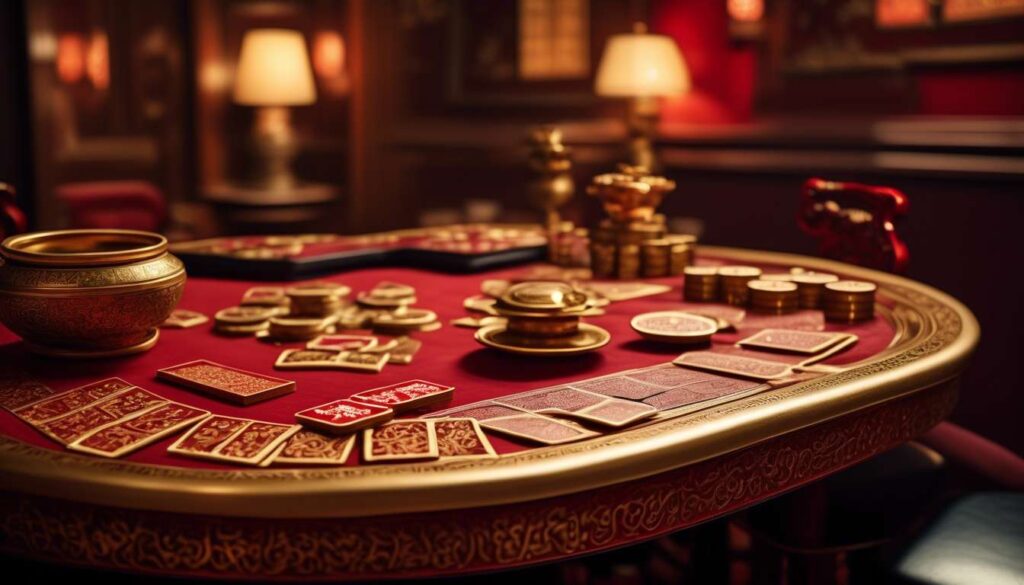As we delve into the captivating world of Pai Gow Tiles, we invite you to join us on a journey through the rich tapestry of traditional Chinese gambling. Together, we will explore the origins and intricacies of this ancient game, which has intrigued and entertained players for centuries.
Our guide aims to demystify Pai Gow Tiles, shedding light on its rules, strategies, and cultural significance. We will uncover the allure that has drawn players to its unique blend of skill and chance and share insights into how this game has evolved over time.
Key Concepts:
-
Origins and History: Understand how Pai Gow Tiles emerged in Chinese culture and its historical significance.
-
Rules and Gameplay: Learn the fundamental rules that govern the game and how to set your tiles effectively.
-
Strategies for Success: Discover strategic approaches to enhance your gameplay and increase your chances of winning.
-
Cultural Significance: Explore how Pai Gow Tiles is more than just a game, reflecting social and cultural elements of Chinese tradition.
As we navigate through its complexities, we will also celebrate the communal spirit that Pai Gow fosters, emphasizing the importance of camaraderie and patience at the gaming table.
Whether you are a seasoned enthusiast or a curious newcomer, let us embark on this exploration of Pai Gow Tiles together and discover the timeless appeal of this traditional pastime.
History and Origins
Pai Gow Tiles, a game steeped in tradition, traces its origins back to ancient China, where it was first played by the Song Dynasty. During this time, there was a strong sense of community and belonging centered around shared activities like Pai Gow. The game wasn’t just a pastime; it was an opportunity to gather, strategize, and connect over a shared love for challenge and tradition.
Strategy was integral from the very beginning. Each tile held significance, and the way they were paired required thought and insight. This reflects the strategic mindset of our ancestors. They passed down their knowledge and skills, creating a rich tapestry of tradition that binds us even today.
In learning about Pai Gow’s history, we feel a deeper connection to those who came before us. Embracing this legacy, we recognize that the game is more than just tiles—it’s a bridge to our shared past and cultural identity.
Understanding the Rules
To fully enjoy the game, we must grasp the essential rules that govern how Pai Gow Tiles is played. As we immerse ourselves in this traditional Chinese game, we find a sense of connection with a rich cultural heritage.
The game is played with 32 tiles, each with its own value and significance. Our goal is to create two hands—a high hand and a low hand—that outperform the dealer’s hands.
Strategically, we must consider the tiles’ rankings and the best possible combinations. The tradition of Pai Gow invites us to think critically and engage with both luck and skill. It’s crucial to know the natural pairs, like the Gee Joon, which can be the most powerful combination.
As players, we’re not just participants; we’re part of a long-standing tradition where strategy and camaraderie flourish. By understanding these rules, we’re better equipped to enjoy the game, fostering a sense of belonging within this timeless community.
Setting Your Tiles
Arranging our tiles thoughtfully is key to forming a strong high hand and low hand, maximizing our chances of winning.
In Pai Gow, we embrace both strategy and tradition, an engaging blend that brings us together around the table. When setting our tiles, we aim to create a high hand (our back hand) and a low hand (our front hand) that work harmoniously. Tradition dictates that the high hand should be stronger, yet it’s essential not to overlook the low hand’s potential.
Key considerations when setting your hands:
- Pay attention to the tiles’ ranking.
- Form pairs strategically.
- Seek a balance that reflects both skill and respect for the game’s rich history.
Sharing tips and strategies among friends fosters a sense of camaraderie, as we collectively delve deeper into this timeless pastime. By understanding the nuances of Pai Gow, we not only improve our game but also forge lasting connections, becoming part of a shared cultural heritage.
Strategic Gameplay Tips
Strategic Gameplay Tips for Pai Gow:
1. Balance Your Hands
- Focus on creating a strong front hand and an even stronger back hand.
- This balance is crucial as it respects the tradition of Pai Gow and provides a solid foundation to challenge opponents.
2. Understand Tile Values
- Pay close attention to the value hierarchy of the tiles.
- Knowing these values helps you make informed decisions, ensuring your hands reflect a sound strategy.
- Remember, Pai Gow is not just about luck; it’s about making calculated moves that honor the game’s traditions.
3. Remain Adaptable
- Observe your opponents’ strategies and adjust your play accordingly.
- Staying flexible keeps you connected to the game and the community.
- Embrace both the shared excitement and the individual mastery of Pai Gow.
Together, these strategies deepen our appreciation for this timeless game and sharpen our competitive edge. Embrace the rich tradition of Pai Gow by understanding its core strategy, which is key to elevating your gameplay experience.
Enhancing Your Chances to Win
To boost our winning odds, focus on:
-
Mastering Tile Combinations
- Understanding the nuances of each tile set is crucial.
- Study these combinations to develop a keen sense of strategy that aligns with the game’s tradition.
- Remember, Pai Gow isn’t just about luck; it’s about skillfully navigating each round and making informed decisions.
-
Anticipating Opponents’ Moves
- Pay attention to the flow of the game by observing opponents closely.
- By reading their actions, we can predict their strategies and adjust ours accordingly.
- This enhances our chances to win and deepens our connection with the communal experience of playing Pai Gow.
Participating in Pai Gow means:
- Joining a community that cherishes both competition and camaraderie.
- As we refine our strategy and embrace the traditions of Pai Gow, we strengthen our bonds with fellow players.
- Celebrating every victory and learning from each loss together.
By focusing on these aspects, we not only improve our gameplay but also honor the rich tradition of Pai Gow.
Cultural Insights and Traditions
Rich cultural insights and longstanding traditions form the backbone of our Pai Gow experience, offering us a deeper appreciation of the game’s historical roots and communal spirit. As we gather around the table, we’re not just engaging in a game; we’re participating in a tradition that has connected generations.
Pai Gow teaches us more than just strategy—it immerses us in a world where each tile tells a story, and each hand we play is steeped in history. Our strategy often mirrors the wisdom passed down through the ages. Embracing these traditions, we find ourselves part of a larger community that values both skill and heritage.
The rituals surrounding Pai Gow remind us of the importance of respect and patience, qualities that transcend the game itself. By understanding the cultural nuances, we deepen our bond with the game and those who play it, ensuring that we’re not just spectators, but active participants in this rich tradition.
Embracing Communal Spirit
Gathering around the Pai Gow table, we embrace a communal spirit that fosters camaraderie and shared enjoyment. In this setting, the game is more than just a test of strategy; it’s a celebration of tradition and togetherness. We find comfort in knowing that our fellow players are there to enjoy the experience with us, each bringing their unique insights and strategies to the table.
As we lay down our tiles, we share in the excitement and anticipation, each move drawing us closer. The tradition of Pai Gow transcends the mere act of playing; it’s about connecting with one another, forming bonds, and learning from each other.
- The shared laughter
- The collective groans
- The moments of triumph
All contribute to a sense of belonging that enriches our experience.
We might focus on our individual strategies, yet we’re united by the game itself. Pai Gow becomes a bridge, connecting us through the shared pursuit of enjoyment and friendly competition.
Timeless Appeal of Pai Gow
Throughout generations, we’ve been captivated by the enduring charm of Pai Gow, appreciating how it seamlessly blends skill, chance, and cultural heritage. This traditional game is more than just a pastime; it’s a cherished ritual that connects us to our roots.
As we gather around the table, we feel the pull of a shared history, each tile whispering tales of strategy and chance. In Pai Gow, strategy isn’t merely a technique—it’s an art form passed down through the ages, inviting each of us to engage with its complexities and nuances.
Pai Gow’s timeless appeal lies in its ability to foster a sense of community. We find ourselves drawn into a circle of camaraderie, united by our love for the game and its traditions. It offers us a space where skill and luck coexist, reminding us of life’s unpredictability while celebrating our shared culture.
In every shuffle and deal, we cherish the bonds we create and the legacy we continue.
Conclusion
Now that you’ve delved into the world of Pai Gow Tiles, you’ve gained insights into its rich history, rules, and strategies.
By setting your tiles strategically and embracing the communal spirit, you can enhance your chances of winning in this traditional Chinese gambling game.
Remember, the timeless appeal of Pai Gow lies in its blend of:
- Skill
- Luck
- Cultural traditions
So gather your friends, set your tiles, and enjoy the thrill of this age-old game!

